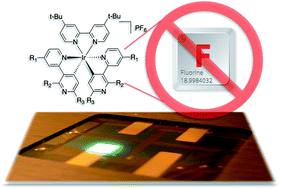Fluorine-free blue-green emitters for light-emitting electrochemical cells†
Abstract
There is presently a lack of efficient and stable blue emitters for light-emitting electrochemical cells (LEECs), which limits the development of white light emitting systems for lighting. Cyclometalated iridium complexes as blue emitters tend to show low photoluminescence efficiency due to significant ligand-centred character of the radiative transition. The most common strategy to blue-shift the emission is to use fluorine substituents on the cyclometalating ligand, such as 2,4-difluorophenylpyridine, dFppy, which has been shown to decrease the stability of the emitter in operating devices. Herein we report a series of four new charged cyclometalated iridium complexes using methoxy- and methyl-substituted 2,3′-bipyridine as the main ligands. The combination of donor groups and the use of a cyclometalated pyridine has been recently reported for neutral complexes and found electronically equivalent to dFppy. We describe the photophysical and electrochemical properties of the complexes in solution and use DFT and TDDFT calculations to gain insights into their properties. The complexes exhibit bluish-green emission with onsets around 450 nm, which correspond to the maximum emission at 77 K. Furthermore, photoluminescence quantum yields in solution are all above 40%, with the brightest in the series at 66%. Finally, LEECs were prepared using these complexes as the emissive material to evaluate the performance of this particular design. Compared to previously reported devices with fluorine-containing emitters, the emitted colours are slightly red-shifted due to methyl substituents on the coordinating pyridine of the main ligand and overall device performances, unfortunately including the stability of devices, are similar to those previously reported. Interestingly within the series of complexes there appears to be a positive effect of the methoxy-substituents on the stability of the devices. The poor stability is therefore attributed to the combination of cyclometalated pyridine and methoxy groups.


 Please wait while we load your content...
Please wait while we load your content...